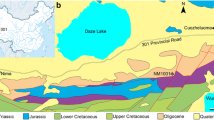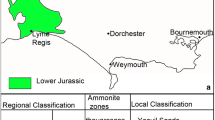Abstract
A new Eocene catostomid genus and species, Plesiomyxocyprinus arratiae, is described from Huadian, Jilin Province, northeastern China. The materials include a nearly complete skeleton, dozens of pharyngeal bones with teeth, and a number of disarticulated bones. The new articulated specimen is large-sized and deep-bodied, with an estimated standard length of ca. 300 mm and body depth of 156 mm or about half of its standard length. The assignment of the fish to the Catostomidae is based on its falciform pharyngeal bone with one row of numerous (more than 50) compressed teeth, and the bone is much smaller than in cyprinids, especially given the size of the fish. The new fish distinguishes itself from all known catostomids (both extinct and extant) in its long anal fin with four unbranched and 17–18 branched rays, and its extremely short caudal peduncle that is only about one fourth of its depth. Plesiomyxocyprinus arratiae resembles the Eocene-Oligocene transpacific-distributed Amyzon in many general skeletal characters. However, it shows a few characters uniquely shared with the Recent catostomid Myxocyprinus asiaticus. Those include a very long dorsal fin with about 50 branched fin rays, the end of dorsal fin rays being close to the caudal fin base, and anal rays stretching posteriorly beyond the base of caudal fin. It is the first fossil catostomid that shows a close relationship to the endemic Myxocyprinus now living in the Yangtze River and Minjiang River, China. The discovery of Plesiomyxocyprinus arratiae, along with two previously described possible catostomid genera Jianghanichthys and Vasnetzovia, may indicate that the divergence of the Catostomidae started much earlier, in the middle Eocene or earlier, on the western side of the Pacific than on its eastern side.
Similar content being viewed by others
References
Smith G R. Phylogeny and biogeography of the Catostomidae, freshwater fishes of North America and Asia. In: Mayden R L, ed. Systematics, Historical Ecology, and North American Freshwater Fishes. Stanford: Stanford University Press, 1992. 778–826
Nelson J S. Fishes of the World. 4th ed. New Jersey: John Wiley & Sons Inc., 2006. 143–146
Meng Q W, Su J X, Miao X Z. Systematics of Fishes (in Chinese with English abstract). Beijing: China Agriculture Press, 1995. 176–177
Sytchevskaya E K. Paleogene freshwater fish fauna of the USSR and Mongolia. Joint Soviet-Mongolian Palaeotological Expedition Transactions (in Russian), 1986, 39: 77–82
Chang M M, Miao D S, Chen Y Y, et al. Suckers (Fish, Catostomidae) from the Eocene of China account for the family’s current disjunct distributions. Sci China Ser D-Earth Sci, 2001, 44(7): 577–586
Chang M M, Zhou J J. A brief survey of the Chinese Eocene Ichthyofauna. Kaupia, Darmstadter Beitrage zur Naturgeschichte, Heft 2, 1993, 15: 157–162
Chang M M, Chen Y Y. Late Mesozoic and Tertiary ichthyofaunas from China and some puzzling patterns of distribution. Vert PalAsiat, 2000, 38(3): 161–175
Chang M M, Chen G J. Fossil Cypriniformes from China and its adjacent areas and their plaeogeographical implication. Geol Soc Spec Pub, 2008, 295: 337–350
Hussakof L. The fossil fishes collected by the Central Asiatic Expedition. Amer Mus Novit, 1932, 553: 1–19
Nelson E M. The opercular series of the Catostomidae. J Morph, 1949, 85: 559–567
Cheng C C. Fossil fishes from the early Teriary of Hsianghsiang, Hunan, with discussion of age of the Hsiawanpu formation (in Chinese with English Summary). Vert PalAsiat, 1962, 6(4): 333–348
Cope E D. On the Tertiary coal and fossils of Osino, Nevada. Proc Amer Philos Soc, 1872, 12: 478–481
Wilson M V H. Oldest known Esox (Pisces: Esocidae), part of a new Paleocene teleost fauna from western Canada. Can J Earth Sci, 1980, 17: 307–312
Cavender T M. Review of the fossil history of North American freshwater fishes. In: Hocutt C H, Wiley E O eds. The Zoogeography of North American Freshwater Fishes. New York: Wiley, 1986. 700–724
Bruner J C. Comments on the genus Amyzon family Catostomidae. J Paleontol, 1991, 65(4): 678–686
Miller R R, Smith G R. New fossil fishes from Plio-Pleistocene Lake Idaho. Occ Pap Mus Zool Univ Michigan, 1967, 654: 1–24
Smith G R, Lundberg J. The Sand Draw fish fauna. In: Skinner M F, et al., eds. Early Pleistocene Preglacial and Glacial Rocks and Faunas of North-C - entral Nebraska. Bull Amer Mus Nat His, 1972, 148: 40–54
Miller R R, Smith G R. Distribution and evolution of Chasmistes (Pisces: Catostomidae) in western North America. Occ Pap Mus Zool Univ Michigan, 1981, 696: 1–46
Smith G R. Fishes of the Pliocene Glenns Ferry Formation, Southwest Idaho. Univ Mich Mus Paleontol Pap Paleontol, 1975, 14: 1–68
Alvarado-Ortega J, Carranza-Castaneda O, Alvarez-Reyes G. A new fossil species of Ictiobus (Teleostei: Catostomidae) from Pliocene lacustrine sediments near Tula de Allende, Hidalgo, Mexico. J Paleontol, 2006, 80(5): 993–1008
Smith G R, Stokes W L, Horn K F. Some late Pleistocene fishes of Lake Bonneville. Copeia, 1968, (4): 807–816
Smith G R. Late Cenozoic freshwater fishes of North America. Annu Rev Ecol Syst, 1981, (12): 163–193
Hubbs C L. Materials for a revision of the catostomid fishes of eastern North America. Misc Publ Mus Zool Univ Michigan, 1930, 20: 1–47
Nelson E M. The comparative morphology of the Weberian apparatus of the Catostomidae and its significance in systematics. J Morph, 1948, 83: 225–251
Smith G R, Koehn R K. Phenetic and cladistic studies of biochemical and morphological characteristics of Catostomus. Syst Zool, 1971, 20(3): 282–297
Ferris S D, Whitt G S. Phylogeny of tetraploid catostomid fishes based on the loss of duplicate gene expression. Syst Zool, 1978, 27: 189–206
Fuiman L A. Contribution of developmental characters to a phylogeny of catomid fishes, with comments on heterochrony. Copeia, 1985, (4): 833–846
Harris P M, Mayden R L. Phylogenetic relationships of major clades of catostomidae (Teleostei: Cypriniformes) as inferred from mitochondrial SSU and LSU rDNA sequences. Mol Phylogenet Evol, 2001, 20(2): 225–237
Sun Y H, Xie C X, Wang W M, et al. The genetic variation and biogeography of catostomid fishes based on mitochondrial and nucleic DNA sequences. J Fish Biol, 2007, 70(Suppl C): 291–309
Bureau of Geology and Mineral Resources of Jilin Province. Regional Geology of Jilin Province (in Chinese). Beijing: Geological Publishing House, 1988. 1–698
Zhang P L, Lü B C, Li C T, et al. Discovery of the Hudian Fauna of the early Tertiary and its geological significance (in Chinese with English abstract). Jilin Geo, 1986, (4): 1–16
Wang B Y, Li C T. First Paleogene mammalian fauna from northeastern China (in Chinese with English summary). Vert PalAsiat, 1990, 28(3): 165–205
Zhao X, Zhang X, Wang M, et al. The assemblage of Neogene sporopollen of Tumenzi Formation of Hunchun, Jilin Province (in Chinese with English abstract). J Shandong Univ Sci Tech (Nat Sci), 2004, 23(1): 19–23
Zhou J J, Sun J R. Early Eocene fish fauna found in Huadian Basin, Jilin (in Chinese). Vert PalAsiat, 1985, 23(2): 170
Hou L, Ericson P. A middle Eocene shorebird from China. The Condor, 2002, 104(4): 896–899
Gradstein F M, Ogg J G, Smith A G. A Geological Time Scale 2004. Cambridge: Cambridge University Press, 2004. 1–589
Talylor W R, Van Dyke G C. Revised procedures for staining and clearing small fishes and other vertebrates for bone and cartilage study. Cybium, 1985, 9(2): 107–119
Chu Y T. Comparative Studies on the Scales and on the Pharyngeal and Their Teeth in Chinese Cyprinids, with Particular Reference to Taxonomy and Evolution. Shanghai: St. John’s University, 1935. 1–225
Eastman J T. The pharyngeal bones and teeth of catostomid fishes. Amer Midl Nat, 1977, 97(1): 68–88
Wilson M V H. Middle Eocene freshwater fishes from British Columbia. Life Sci Contr Roy Ontario Mus, 1977, 113: 1–61
Grande L, Eastman J T, Cavender T M. Amyzon gosiutensis, a new catostomid fish from the Green River Formation. Copeia, 1982, (3): 523–532
Smith G R. Distribution and evolution of the North American catostomid fishes of the subgenus pantosteus, genus Catostomus. Misc Publ Mus Zool Univ Michigan, 1966, 129: 1–132
Weisel G F. The osteocranium of the catostomid fish, Catostomus macrocheilus: A study on adaptation and natural relationship. J Morph, 1960, (106): 109–129
Eastman J T. The caudal skeletons of catostomid fishes. Amer Midl Nat, 1980, 103(1): 133–148
Fang P W. Notes on Myxocyprinus asiaticus (Bleeker) in Chinese fresh-waters. Sinensia, 1934, 4(1): 329–337
Lei Y Z. Vertebrates. In: Hubei Institute of Geological Science, Bureau of Geology of Henan Province ed. Atlas of Fossils from Central-Southern China (in Chinese). Beijing: Geological Publishing House, 1977. 133–136
Lei Y Z. Fish. In: Yichang Institute of Geology and Mineral Resources, Ministry of Geology and Mineral Resources ed. Biostratigraphy of the Yangtze Gorges area, 5 Cretaceaous and Tertiary (in Chinese with English summary). Beijing: Geological Publishing House, 1987. 191–194
Author information
Authors and Affiliations
Corresponding author
Additional information
Supported by National Natural Science Foundation of China (Grant No. 40432003, J0630965), Cypriniformes Tree of Life under the U.S. National Science Foundation to R. Mayden (Grant No. EF0431326), and Ecocarp Project (European Commission, INCO-DEV Programme) (Grant No. ICA4-CT-2001- 10024)
Rights and permissions
About this article
Cite this article
Liu, J., Chang, Mm. A new Eocene catostomid (Teleostei: Cypriniformes) from northeastern China and early divergence of Catostomidae. Sci. China Ser. D-Earth Sci. 52, 189–202 (2009). https://doi.org/10.1007/s11430-009-0022-2
Received:
Accepted:
Published:
Issue Date:
DOI: https://doi.org/10.1007/s11430-009-0022-2




